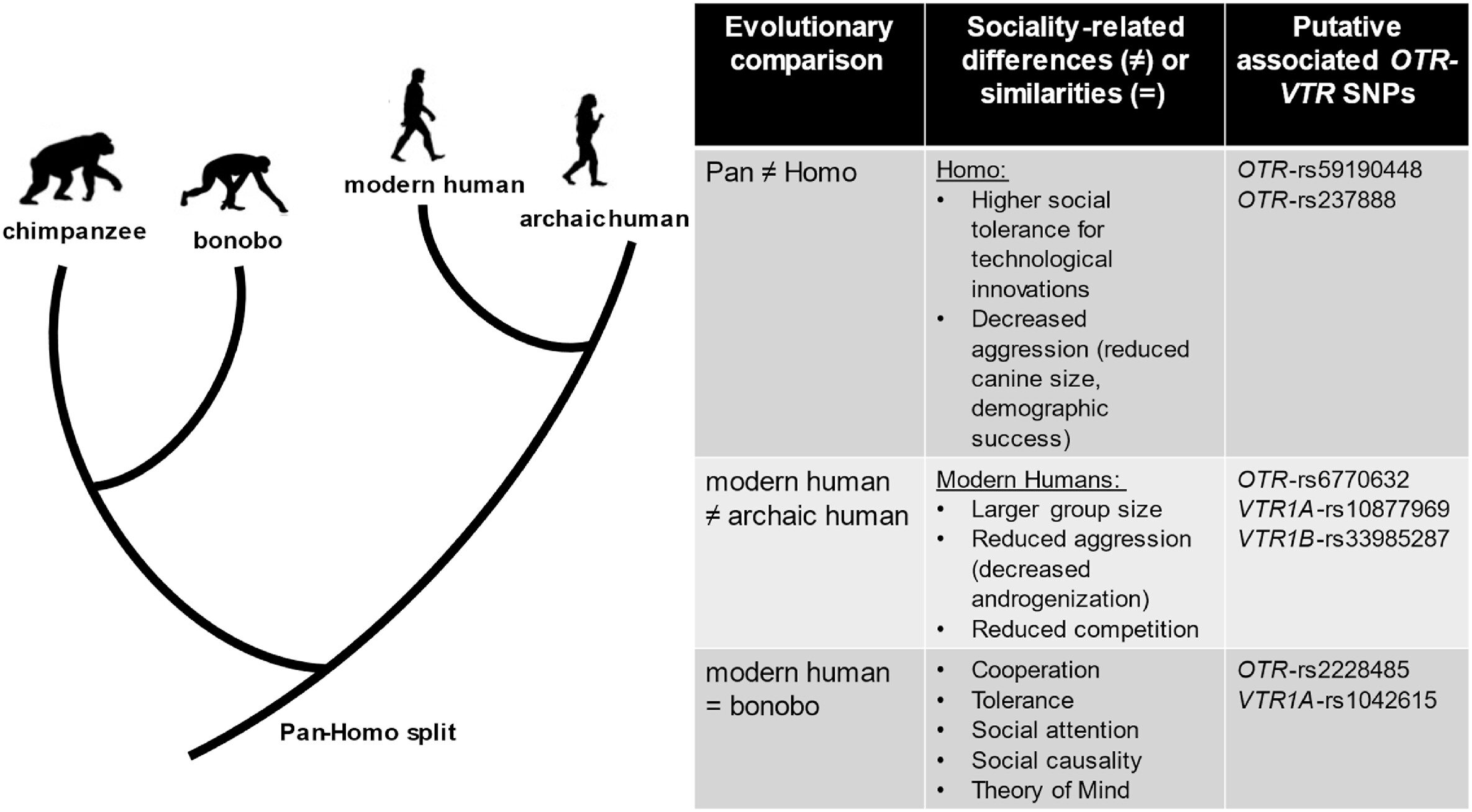#What oxytocin can tell us about the evolution of human prosociality

Table of Contents
“What oxytocin can tell us about the evolution of human prosociality”

Modern humans are characterized by their prosociality, a broad term that encompasses intraspecies empathy, social tolerance, cooperation and altruism. These facets of social cognition have been associated with variations in the oxytocin and vasotocin genes (OT and VT) and their receptors (OTR and VTR). To shed light on the genetic basis of this behavior, scientists from the University of Barcelona (UB) and Rockefeller University carried out a new study comparing the available genomic sequences of these genes between modern humans, non-human primate species (e.g., chimpanzees, bonobos, and macaques) and, for the first time, archaic humans, using all the available genomes of Neanderthals and Denisovans.
In the study, published in the journal Comprehensive Psychoneuroendocrinology, the researchers identified several sites in which modern humans differed from both archaic humans and non-human primates, and others where both modern and archaic humans differed from non-human primates.
“We used an interdisciplinary approach to understand the evolution of hominid prosociality through the lens of the oxytocin and vasotocin receptors, where we combined evidence from modern and archaic genomics, population genetics, transcriptomics, and behavioral and neuroscientific studies, among other methods. These results can shed light on the genetics underlying possible sociality differences identified between modern humans and archaic humans, as well as the similarities between the modern human and bonobo social behavior,” said first author Constantina Theofanopoulou. This research is part of her doctoral thesis carried out under the co-supervision of Cedric Boeckx, ICREA researcher at the Institute of Complex Systems at the UB (UBICS) and Erich D. Jarvis, professor at Rockefeller University.
Variants unique to modern humans in more than 70% of the population
Considering the evidence on modern human prosociality and on the involvement of the oxytocin and vasotocin genes in social behaviors, the researchers hypothesized that the evolution of these genes might elucidate the genetic basis of the evolution of hominin prosociality. With this aim in mind, the study explored the differences between modern humans, archaic humans and non-human primates in polymorphic heterozygous sites in the human genome—locations where at least two alternative sequences are found in a population.
“Past studies that compared the entire modern human genome with the Neanderthal or the chimpanzee genomes have focused on changes that are fixed or nearly fixed in modern humans. This has led to them identifying sites where, for example, all Neanderthals had Adenine (one of the four nucleotides that with guanine, cytosine and thymine form the DNA) and nearly all modern humans (say, 98%) have Guanine. In this study, we searched for differences on locations where, by definition, not all modern humans share the same nucleotide, namely on polymorphic sites, where for example, 70% of the modern human population has Adenine and 30% Cytosine,” adds Theofanopoulou.
The researchers identified five sites in the oxytocin and vasotocin receptors where modern humans are unique in one of their two (or more) variants compared to archaic humans and non-human primates, and which are at the same time found in more than 70% of the modern human population. Next, they conducted functional and frequency analyses to establish whether the variants are relevant. They performed a range of analyses on the five sites and found that some of the variants are highly functional, indicating that they have an effect on the molecular function of the proteins activated by these genes.
The researchers also found that these sites are encountered in genome regions that are active in the brain, particularly in the cingulate gyrus, a brain region involved in social cognition-relevant pathways. Moreover, all these sites have been associated in other studies with a plethora of social behaviors or social deficits, such as autism, attention deficit hyperactivity disorder (ADHD), aggression, and so on.
These findings may help to explain some of the social differences between modern humans and what we presume to know about the social behaviors of Neanderthals and Denisovans. “For example, they might be relevant to the smaller social groups attributed to Neanderthals and Denisovans or to the decreased modern human androgenization. They might also be relevant to a different social structure, i.e., Neanderthals have been linked to a polygynous social structure and a higher level of male–male competition than most contemporary modern human populations,” says Constantina Theofanopoulou.
Variants present only in modern and archaic humans
The study also found two sites on the oxytocin receptor under a positive selection in modern and archaic humans: that is to say, modern and archaic humans showed a variant that was not present in any other non-human primate. This means that these sites are found in very high percentages in the modern human population (in this case, more than 85%). These same sites have also been associated with a great many social behaviors or deficits, and one of them was predicted to be a highly functional site in their regulation analyses. “The sites that are unique in both us and archaic humans versus non-human primates can elucidate the genetic underpinnings of the progressive social tolerance needed for the intensive cultural transmission of technological innovations (e.g., fire use) in the evolution of humankind, as well as for the reduced aggression indicated by several markers in early hominid evolution, such as the reduction of male canine size and the accelerated demographic success,” adds Theofanopoulou.
Convergent sites with bonobos
Lastly, the researchers found three sites where modern humans and bonobos, a primate species that shows convergence of prosocial behaviors with humans, have the same nucleotide. “The convergent sites in modern humans and bonobos could be insightful for understanding the posited similarities in prosociality, social tolerance and cooperation between us and bonobos, and the differences of both compared to chimpanzees. For example, bonobos outperform chimpanzees on tasks relevant to social causality or theory of mind and are more attentive to the face and eyes, suggestive of higher empathic sensitivity,” notes the researcher.
All the sites identified in this study have also been independently associated with disorders that include social deficits, such as autism spectrum disorders (ASD). “Understanding developmental disorders through evolutionary lenses can aid into us achieving what we call an evo-devo (evolutionary and developmental biology) understanding of these disorders. If indeed ‘ontogeny recapitulates phylogeny,’ then deciphering our evolutionary trajectory may shed light to new genetic spots for clinical research that might, in turn, lead to earlier disorder diagnosis,” says Constantina Theofanopoulou.
Future research in larger sample sizes
The next step in this research would be to test these results in larger sample sizes. This objective, as Theofanopoulou says, “is easier” to achieve in non-human primates such as chimpanzees and bonobos, but “is more difficult in the case of Neanderthals or Denisovans,” since obtaining access to more archaic genomes depends on archaeological finds, among other factors. “Another step is to widen the scope of the research and include more genes of the oxytocin pathway, or other genes highlighted in human evolution, such as dopamine,” concludes the researcher.
Decoding human history with ancient DNA
Constantina Theofanopoulou et al, Oxytocin and vasotocin receptor variation and the evolution of human prosociality, Comprehensive Psychoneuroendocrinology (2022). DOI: 10.1016/j.cpnec.2022.100139
Citation:
What oxytocin can tell us about the evolution of human prosociality (2022, June 2)
retrieved 2 June 2022
from https://phys.org/news/2022-06-oxytocin-evolution-human-prosociality.html
This document is subject to copyright. Apart from any fair dealing for the purpose of private study or research, no
part may be reproduced without the written permission. The content is provided for information purposes only.
If you liked the article, do not forget to share it with your friends. Follow us on Google News too, click on the star and choose us from your favorites.
For forums sites go to Forum.BuradaBiliyorum.Com
If you want to read more Like this articles, you can visit our Science category.




